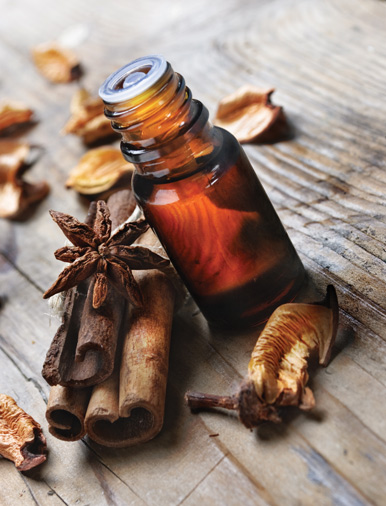An Ayurvedic Practice to Awaken Perception
By Jeff Perlman
Imagine taking a simple inhalation that is far more powerful than one of the hundreds of unconscious breaths you take each day. This inhalation carries the magic of an Ayurvedic herbal formula that not only awakens your perception, but also stimulates your intelligence and balances the mind.
And it’s legal.
This is nasya, the Ayurvedic practice of lubricating and nasal passages with medicated ghee or herbalized oils as a vehicle for administering herbs to the nervous system and the rest of the body. This practice is especially important in conjunction with neti or Ayurvedic nasal irrigation with salt water, which clears out debris in the nasal passages, yet can often leave them dried out.
Nasya is defined in Sanskrit as “belonging to or being in the nose” and is universally understood as one of the of the five panchakarma (Ayurvedic detoxification) techniques used for cleansing the body. Traditionally, six different types of nasya treatments are administered based on specific imbalances and individual needs. These can include dry powders blown into the nasal passages, medicated oils and ghee, and medicated concoctions including teas or juices. The type you’ll encounter most often is nasya oil, which is a combination of oils including; ghee, sesame, coconut, olive, etc. infused with herbs and sometimes including essential oils.
The nose is the gateway into the head, sinuses and lungs, and our breath carries prana, “the life force,” which enters via the nasal passages and connects to our intelligence and consciousness. The practice of nasya not only delivers needed lubrication and medicine into the body, but also supports the digestion of prana, which governs all sensory-motor functions and cerebral activities. It can bring more focus and presence to a meditation and pranayama practice by heightening prana and mental acuity.
When our prana becomes unbalanced, it can affect our neurological and physiological functions, resulting in imbalances such as headaches, migraines, hoarseness of voice, stuttering or slurred speech, stiffness in the head, neck, throat or jaw (such as TMJ), thyroid condition, pain in the ears, nose or throat, Parkinson’s disease, multiple sclerosis, and strokes. Psychologically, imbalanced prana can affect our mental, emotional and spiritual balance resulting with symptoms like anxiety, fear, anger and depression. The use of medicated ghee in nasya treatment increases ojas, the body’s ‘vital nectar of life” and is believed in Ayurveda to stimulate stem cell production, which also repairs and regenerates bodily organs and functions.
Nasya can be incorporated within in your (daily routine). Having a regular daily routine is an important tenant of Ayurveda. A daily routine could include waking up early when the qualities that surround you are at their purest, engaging in prayer and meditation, scraping the tongue, cleansing and lubricating the nasal passages, strengthening the gums and teeth, and the practice of meditation, asana, and pranayama.
It is not recommend to use nasya oil on young children under the age of seven or with the elderly over 80, during menstruation and pregnancy, on a full stomach or when very hungry, when experiencing active inflammation or diarrhea, when intoxicated, and during acute health conditions such as high fever. If you are using a neti pot in your practice it is recommended to let the nasal passages dry out before administering any oil.
 How to Use Nasya Oil
How to Use Nasya Oil
Incorporate the following procedure for administering the oil:
First lie down on your back, tilting your head back looking towards the ceiling or if you are on a bed, you may hang your head off the edge.
Place 3-5 drops of nasya oil in each nostril, and massage the outside perimeter of the nostril in a circular motion to ensure drops go down the nasal passage.
Breathe in with a light force and then rest for a minute or two allowing the oil to penetrate across the mucous membranes.
There are many sources and brands of nasya oil on the market. You can find them at your local co-op, health food store, and natural pharmacy or online. No surprise, one of my favorites is the one I make in my practice, but of the commercial nasya oils available, I prefer the “Super Nasya” oil produced and distributed by the Ayurvedic Institute in New Mexico ayurveda.com.
If you want to venture into making your own, here is the one I use in my practice, which is tri-doshic (appropriate for all the doshas).
Jeff Perlman is a Clinical Ayurvedic & Pancha Karma Specialist, Certified Iyengar Yoga Instructor,
Certified Massage and Marma Therapist, a professional member of the National Ayurvedic
Medical Association and a Cordon Bleu Chef.
He sells the nasya oil formula above and is available for private consultations. You can contact him at jeff@tsayurveda.com or visit his website: www.threeseasonsayurveda.com
Jeff Perlman is a Clinical Ayurvedic & Pancha Karma Specialist, Certified Iyengar Yoga Instructor, Certified Massage and Marma Therapist, a professional member of the National Ayurvedic Medical Association and a Cordon Bleu Chef. He is available for private consultations. He leads annual trips to India. You can contact him at jeff@tsayurveda.com or visit his website: threeseasonsayurveda.com
